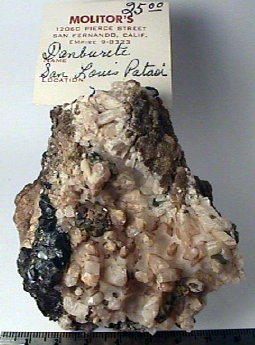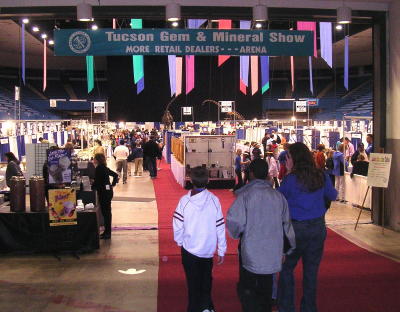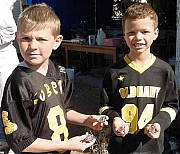by Robert Verish
![]()
by Robert Verish
Mineral Collecting - a Hobby in Decline -
Could This Happen to Meteorite Collecting?
A letter to the editor of Mineral News in response to an article in that publication that was originally published in May, 2005
In my June 2005 Bob's Findings article I transcribed a couple of articles about the hobby of mineral collecting which originally appeared in the monthly newsletter, Mineral News. In the interim a letter has been sent to the editor of Mineral News which has been subseqently published in that newsletter. This "letter to the editor" was written by P. Powhat and is in response to James E. Rumrill's article about the decline in the popularity of mineral collecting, which was entitled, "Observations By a Pessimist". It is only fitting that my article this month be a transcription of that "letter to the editor".
Given that the main gathering of meteorite collectors (such as the "Tucson Show") typically ride the coat-tails of Mineral Shows, it can be argued that there is a connection between meteorite collecting and mineral collecting. But, there is little arguement that the hobby of mineral collecting has been in a state of constant decline since its popularity peaked in the mid-1950's. What with the hobby of meteorite collecting presently at its peak, it is difficult to envision a future where this hobby would suffer a similar fate. But, could this hobby lose its popularity? Is it possible?
Decide for yourself by reading the article that I have reprinted below:
***************************************************
Mineral News July
2005
A Reaction to "Observations By
a Pessimist"
By P. Powhat
Upon reading James E. Rumrill's
small piece, entitled "Observations by a Pessimist," in your last
issue (Mineral News, vol.
21, no. 5, p. 15) I decided to write to you with some ideas of my own. While I
agree with Mr. Rumrill concerning the domination of
leisure time by television and the Internet, I see this as only one aspect of
the decline of mineral collecting in general. As a starting point for my views
I refer to David E. Jensen's revised edition of George L. English's wonderful
book "Getting acquainted with Minerals." Jensen remarks in the
preface "...interest in the hobby of mineral collecting in all its phases
has increased to place it third among all of the hobbies in this country."
This was written in 1958, sadly mineral collecting as a hobby has declined in
this country and others since then. How did this happen?
One striking difference between the collecting scene
in 1958 and that scene today is the dramatic decline in the mining industry in
this country. Mines and quarries are undoubtedly the best sources of mineral
specimens, but these mines have closed either because they have been worked out
or cheaper foreign sources became available. Another major difference between
1958 and today is the increased litigiousness of today's society. In 1958 you
were responsible for following the rules and regulations put forth by
the mine management, or the property owner, where you wanted to collect.
Today those mines, quarries and private properties that remain active will not
permit collecting on their sites by private individuals because they are
now responsible for (our stupidity. Any specimens coming out of active
mines, quarries and private properties are mainly the result of the owners contracting
professional firms, such as Collectors Edge and Geoprime,
to collect and market the specimens. There are some properties where you may still collect on a fee basis, but don't expect to get
anything but mediocre specimens at best from them. What all this means is that
sources of ostensibly free specimens for retention in one's personal collection
and for exchange have all but dried up. It also takes away another pleasant
aspect of collecting back in 1958 - exercise in the great outdoors.
Also, 1958 was near the end of the great uranium
prospecting boom. After the end of WW II the United States was actively seeking
uranium ores for use in the nuclear weapons industry. Along with uranium,
metals such as lithium, beryllium and the semimetal boron, also vital to
national security, were actively prospected for. Citizens started weekend
prospecting trips looking to get rich just like Forty-niners of old. I am sure
a few of you remember magazines such as Popular Mechanics and Popular
Science running articles dealing with how to build your own scintillation
counter, how to recognize uranium ore and how to stake out a claim. Very few of
these weekend prospectors found uranium ore, but many of them got hooked on
mineral collecting. Today we have
nothing like this to spur interest in minerals, and keep in mind that those
uranium boom prospectors are becoming less and less active.
Another
striking difference between collectors in 1958 and those today is the lack of
knowledge concerning the science and lore of mineralogy, crystallography and
geology of collectors today. Today's collector is far too concerned with price
paid or future price to be realized or what trophy can be won with what
combination of expensive specimens or which major collector/museum owned the
specimen before. There is no longer an awe of the wonders that have been
created within the Earth. There is no longer a curiosity about how and why
minerals form. On a certain level mineral collecting has gotten to be like
collecting rare stamps and coins. The advice "Buy the best you can
afford!" has become twisted into meaning "The best is always the
highest price!" This attitude has unfortunately trickled down to the collectors
without the means to afford these "ultra" specimens. Anybody can shop
for specimens by examining the price tag and walk away with some fine pieces.
However, the astute collector with a solid background in basic mineralogy will
be able to assemble a very fine collection at a modest cost. These are the
collectors that can recognize the "sleepers" that are still
available, either underpriced or mislabeled; you just
have to know what to look for, and a knowledge of basic mineralogy can help.
Everybody cannot have the best of the lot, but most collectors can have decent
examples from the lot. The great micromounter, Neil Yedlin, always said "Buy and use a good mineral
book." There is a plethora of books available to guide the beginning and
mid-level collector in the study of minerals. Don't want to avail yourself of
"hard copy?" Then there are also many Internet sites that can be used
to help.

Mineral collecting is a fascinating hobby for a number
of different reasons. A study of minerals is an excellent introduction to
chemistry, physics and mathematics [and meteoritics].
They are the building blocks of the rocks that compose the earth's crust [and
all planetismals], and thus can help us understand
how the earth formed [as well as the solar system], how it continues to be a
dynamic planet. Then there are the historical aspects, in many cases the
minerals are all that is left of many famous mines and mining districts. The
history of the discovery of the chemical elements, and thus of early chemistry
in general, revolves around the chemical analysis of mineral specimens.
Nevertheless, one always comes back to the aesthetically pleasing colors and
crystal habits. How can we start to explain our fascination with what we
consider to be the most interesting of natural history objects? How can we as
collectors, dealers and museum personnel develop a greater interest in minerals
in young people?

Mineral clubs may or may not be the
answer. Many of the clubs I've had occasion to encounter seem so ossified by
Robert's Rules that they are boring and unsatisfying. This is not to say that
all clubs are bad. There are quite a few good organizations in this country;
the Tucson Gem and Mineral Society is a premier example. However, for many
clubs, less Robert's Rule and more hands on demonstrations and lectures would
be a step in the right direction. Have a beginner swap/give away table where
senior club members have duplicate specimens and/or books for the uninitiated
only.

Collectors
could contact the local high school and talk with the earth science teacher
there. Work with the teacher to develop a section on mineralogy that would be
interesting and stimulating, not just a rote recitation of the Mobs Hardness
Scale. A guest lecture by the collector with some his more interesting
specimens could be arranged. If there are places near by that a field trip can
be undertaken then help the teacher plan one and help chaperon it. Invite the
teacher and interested students to visit you at home to show them your
collection and talk about it.
Dealers can also help by stocking cheap
specimens for children and beginners. On Kids Day at a show have those
specimens instead of rock candy available. Pay attention to the children, some
of them are actually interested in what you have and what you have to say.
There are some interested teachers as well, make a free pass available to them
so they can come back on their own.


Take
an active interest in your local natural history museum. Volunteer to be a
docent and escort school or other interested groups through the mineral
displays. If you follow the suggestion I made earlier and work with an earth
science teacher, plan a trip to the museum with the class or just the
interested students. Contact the curator
or the education division of the museum and see if arrangements can be made for
a behind-the-scenes tour for this group. Make donations of specimens or time to
the mineralogy or education department of the museum. While there is currently
an uproar concerning the possible sale of the Philadelphia Academy collection,
I wonder where the uproar was when the collection was moth-balled. Do not sit
blithely by and let what happened to the Philadelphia Academy of Sciences collection
happen in your town. Be proactive if something like that is in the wind, don't
be silent.

In conclusion, I realize that a few of
these suggestions have become cliché among some of us. However, I wrote this
letter because the state of the mineral collecting hobby, one that is not only
a hobby but a career for me, has been on my mind for some time. If this letter
stirs up some controversy all the better, at least then we can start taking
steps to fix the downward spiral I see the hobby going into.
****************************************
The above article was originally published in the monthly periodical Mineral News in July, 2005.
Getting Acquainted with Minerals by George L. English with revised edition and preface by David E. Jensen.

Observations of a Pessimist by James E. Rumrill from his May 2005 article published in Mineral News.
| Mineral News
was founded some twenty years ago by Lanny Ream of Coeur d'Alene, Idaho,
author of the book "Idaho Minerals". Over the years, it developed
a following of avid mineral collectors seeking timely information about
new finds and other items of interest to the collector community.
With the purchase of Mineral News by Excalibur Mineral Corp in 2003, the monthly newsletter has expanded to sixteen pages a month, revitalized its look by improving paper and print quality, and it has added significant features such as frequent book reviews, photographs to supplement new mineral descriptions and a greater focus of articles directed to descriptive mineralogy. |
For for more information, please contact me by email:
Bolide*chaser
![]()